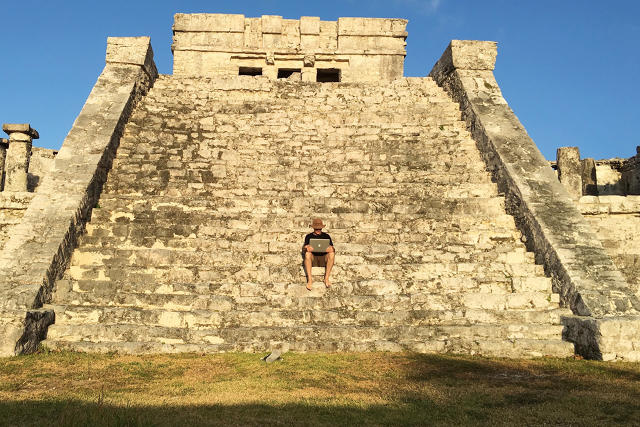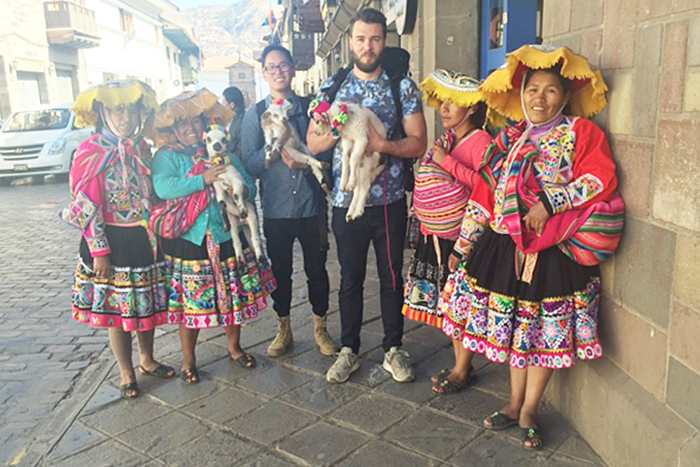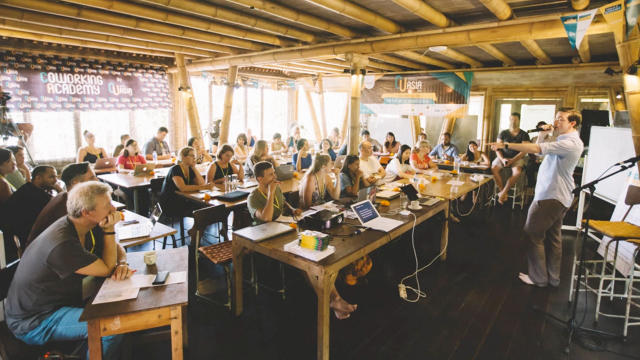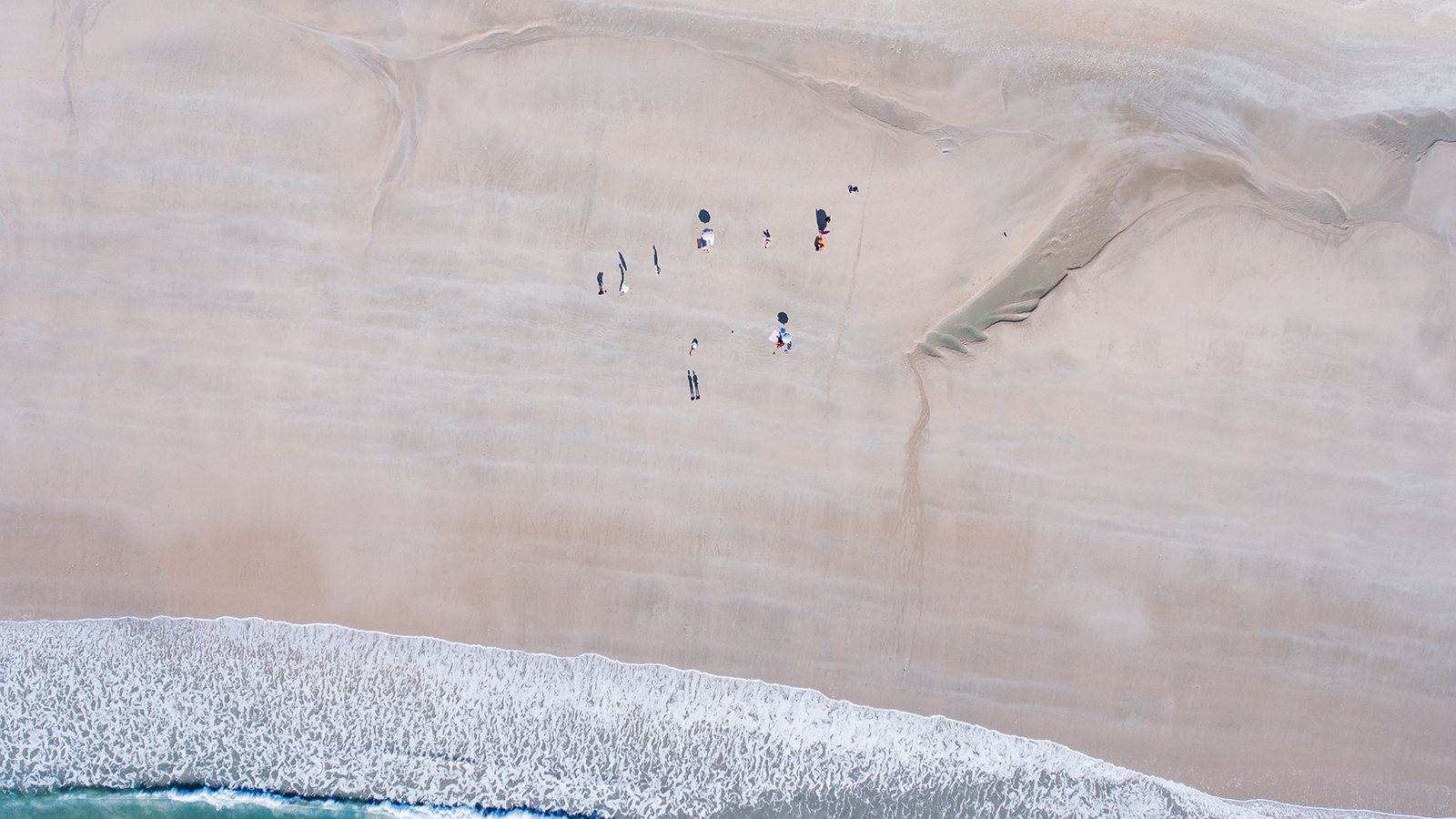This article was sourced from Fast Company. Article by Mike Elgan.
Twenty years ago, a Hitachi executive named Tsugio Makimoto predicted a revolution.
In the future, he wrote, high-speed wireless networks and low-cost mobile devices will break the link between occupation and location. Thanks to Moore and his Law, millions would indulge an innate wanderlust by selling their homes and living abroad, doing their jobs over the internet and enjoying the benefits of first-world income and developing-world cost of living. No more rat-race grind of cubicle and commute.
Makimoto’s vision appeared in his 1997 book Digital Nomad, written with coauthor David Manners. The book was virtually ignored by the public.
Ten years later, the digital nomad idea resurfaced in Tim Ferriss’s 2007 best-selling book The 4-Hour Workweek: Escape 9-5, Live Anywhere, and Join the New Rich. In that hodgepodge of life hacks and business schemes, Ferriss painted a seductive picture of automated income and unbridled globetrotting.
Neither Makimoto nor Ferriss predicted the rise and impact of social networking, smartphone apps, the sharing economy, and on-demand services. Popular apps and services like AirBnb, Whatsapp, Yelp, Lyft, Duolingo, Earth Class Mail, and Google services like Maps, Fi, and Translate, though targeted at the public in general, simplify the digital nomad lifestyle in particular.
The authors also couldn’t have predicted the rise of the digital nomad industrial complex, an entire industry created by and for digital nomads. Whether you’re a digital nomad, aspire to be one, or if you simply travel on business or vacation from time to time, you can benefit from this burgeoning industry.
The real impact of Makimoto’s vision isn’t the possibility of a strange untethered lifestyle for the few. It’s that technology may eventually turn us all into digital nomads. After all, a digital nomad is just another name for a remote worker.
A Gallup poll published this month called “State of the American Workplace” found that 43% of employed Americans worked remotely last year at least some of the time. Moreover, both the length of time working remotely and the number of employees doing so full time has been growing every year. (This is up from 39% in 2012.)
Thanks to the new digital nomad economy, it’s easier than ever to work remotely for the rest of your life or for an hour; from a tent on the Masai Mara or from the Starbucks around the corner. With the exception of two years at an American desk, I’ve done it myself since 2006—from Belize, Cuba, El Salvador, France, Greece, Guatemala, Honduras, Italy, Jordan, Kenya, Mexico, Morocco, Spain, and Turkey.

DROP IN AND GET BUSY
The remote work trend has given rise to the coworking space—office space you can rent for temporary use in the U.S. and all over the world.
The world’s first coworking space opened in London in 1650: The Oxford coffee house. Loosely modeled on establishments in Vienna, which were themselves influenced by coffee houses in Istanbul and elsewhere in the Muslim world, the Oxford started the British coffee house craze. These coffee houses spread quickly throughout London (along with newly found enthusiasm for the stimulating, exotic, and bitter beverage itself).
These coffee houses brewed more than coffee. They became incubators and coworking spaces for all kinds of businesses and newspapers. In fact, insurance giant Lloyd’s of London is named after Edward Lloyd’s coffee house, which opened in 1688, and where the insurance company began as an innovative startup.
Nowadays, coffee houses are everywhere and dedicated coworking businesses are growing fast. Some digital nomads prefer the low cost and often superior chow at coffee houses, while others prefer dedicated coworking spaces that offer acoustic privacy, meeting rooms, and the promise of reliable internet. The choice is often governed by what kind of business you do. If you make calls and hold meetings, coworking spaces are often better.
Whatever your preference, here’s how to track down a spot to work that fits your needs:
• The iOS app Work Hard Anywhere offers a user-ranked directory. CEO Benson Chou told me his app offers 13,000 ranked and crowdsourced “laptop-friendly spaces” in 100 countries. These include cafes, coworking spaces, and even libraries. Spaces are ranked by users according to Wi-Fi quality, outlet availability, seating, parking, price, and other benefits. Chou and cofounder Cody Huang built the app because they struggled to find good places to work in launching their startup. Chou told me that freelancers, entrepreneurs, and students also use the app, but that it really “hit a sweet spot” for digital nomads.
• French IT manager Fabien Vauthey also decided that digital nomads need a crowdsourced, reputation-based directory of both coffee houses and coworking spaces from which to work, so he launched CoWorking.Coffee in 2015, with help from a Tokyo startup incubator. Coffee joints are ranked by quality of Wi-Fi and friendliness to coffee-shop camping (where you sit there working for hours on end). Vauthey told me that he hasn’t monetized the site yet and continues to live as a digital nomad while consulting for various companies.
• One simplifying option for nomads and business travelers alike is to join a network of hundreds of global coworking spaces, such as Copass.
• If you need to find a coworking space on the fly, you can also take advantage of directories like the Global Coworking Map, Desksurfing, Workfrom, Conomads, and Sharedesk.
• One sharing-economy innovation is Hoffice, which is a cross between a coworking directory and AirBnB. The site enables people to offer workspaces in their homes, and for digital nomads to rent them.

JOBS TO GO
For many, the biggest barrier to living nomadically is occupation. How do you find a location-independent job?
Gallup found that remote work opportunities are “increasing across most industries that Gallup has studied.” Still, the majority of digital nomads are freelancers or small business owners, and a disproportionate number of them are developers or content creators of some kind.
• Github, Working Nomads, The Remote Working Company, Remote OK, DigitalNomad JobFinder, We Work Remotely, and RemoteBase all curate lists of remote jobs that can be done from anywhere in the world.
• An Estonian company called Jobbatical connects developers and other “knowledge workers” with one- or two-year jobs all over the world. Companies benefit by quickly hiring engineers and others during crunches, and employees get their foot in the door with a chance to be hired permanently—and the ability to get hired in a foreign country, which can often be difficult.
• Modern Day Nomads curates mostly non-tech, temporary, seasonal, and part-time global jobs.

DIGITAL NOMAD EDUCATION
Until recently, digital nomads were pretty much on their own when figuring out how to earn a living while traveling the world. In the past two or three years, however, a large number of conferences, training programs, and other educational events have emerged, almost all of it by, for, and about digital nomads.
• The annual Nomad Summit in Chiang Mai, Thailand, is run by a digital nomad who goes by the name Johnny FD. He hosts the Travel Like a Bosspodcast and blogs about passive income generation. (FD could be a poster child for the digital nomad financial advantage—he claims to earn between $15,000 and $25,000 per month from Udemy courses, YouTube videos, affiliate links, drop shipping, and book publishing, yet pays only $342 per month for his apartment in Chiang Mai, Thailand.) FD told me his third annual Nomad Summit had more than 350 attendees and attributes the conference’s rapid growth to increasing interest in digital nomad living.
• A conference called DNX Camp is the world’s biggest Conference for digital nomads, according to founder Felicia Hargarten. The event is designed to help digital nomads launch, build, and grow a business that can support a location-independent lifestyle. Their next event is March 1 in Buenos Aires, Argentina. Most of the sessions tackle some aspect of launching and growing a startup. One session is a crash course on how digital nomads can benefit from Estonian e-Residency (the Estonian government offers an e-Resident smart card, enabling nomads to establish an Estonian-based business, bank account, and other benefits of residency without ever living there). The DNX publishes a helpful list of the best tech, sites, apps, books, and services for digital nomads, which is also great for business travelers.
• Coworkstation offers short retreats, from three to seven days, where digital nomads can learn, brainstorm ideas, and enjoy the program’s location. Founder Stuart Jones launched Coworkstation in September 2015 after living as a digital nomad for years (he told me he’s been to more than 70 countries). So far, his company has done three programs in Barcelona, Bali, and on a sailboat in the Mediterranean.
• Speaking of boats, the Nomad Cruise is a two-week “floating conference for digital nomads,” according to founder Johannes Voelkner. The first voyage shoved off in November 2015, from Spain to Brazil. The next one sails from Colombia to Portugal. His three trips served 400 digital nomads from over 40 countries with classes on WordPress, AdWords, blogging, email marketing, artificial intelligence, Facebook Messenger bots, and even a crash course on cryptocurrency, as well as a range of non-technical programs. Voelkner estimates current growth at 200% per year, driven by the rise in digital nomad living.
• YonderWork started as a remote work and travel company, but the rapid rise in digital nomad living soon saturated that market, so the company pivoted to helping companies transition to a remote work culture, according to cofounder Nick Messina and his wife and partner, Kristin. The company supports their own digital nomad lifestyle.
• Companies like 7in7, Coworking Unconference Asia, and Nomad Cityalso offer digital nomad training conferences. Destination: Dev specializes in training and networking for software developers.
• The Freedom Summit is an online virtual summit that provides courses that anyone in the world can join. The next summit is April 1 and 2, and focuses more on the digital nomad lifestyle and less on business. The company also offers a four-week “Freedom Bootcamp Program.”
• The Cocal site provides a calendar of digital nomad conferences and coworking retreats.

PLACES TO LIVE
The housing needs of digital nomads are different from the average traveler. For starters, many nomads like to connect with other freelancers and entrepreneurs. They need fast Wi-Fi. And they often need something longer-term than a hotel room but shorter-term than an apartment.
• A company called Roam offers “flexible housing” for digital nomads in cities like Bali, London, Tokyo, Miami, and San Francisco that can be rented week to week or month to month. Founder and CEO Bruno Haid told me Roam has plans to expand to at least 10 properties by the end of the year. The company says benefits include a community of entrepreneur-travelers as well as help with travel arrangements, available to customers through their website.
• Outsite offers something similar. It’s a kind of subscription service where you pay monthly, but can move around to their various locations. They also promise coworking space.
• If you’re a homeowner or apartment renter and want to keep your housing but also want to live as a digital nomad, a service called 6x2x6 makes it possible. It’s a house-exchange community, but with a difference. Instead of swapping houses directly with one person or family, you can live in the house of another member for between one and three months, then move to the house of yet another user, and so on. You can move from house to house all over the world until you’re ready to return home. All the while, other members are living in your house.
• When digital nomads want to live in a specific place for six months, a year, or a few years, they need a furnished apartment. Nestpick partners with apartment rental sites, extracting only furnished apartments for digital nomads.
• When you’re traveling abroad full time, stuff happens, plans change, and things sometimes don’t work out. Most nomads find themselves needing a place to stay tonight. A service called Overnight is like Hotel Tonight, but for AirBnB-type accommodations—in other words, people’s homes.
• Colive is a user exchange for finding temporary roommates and shared housing while traveling abroad.
• Hotel WiFi Test enables you to choose a hotel based on the most important criteria: how fast the Wi-Fi is.
• If you’re not even sure what country to head for, resources such as Teleport, Nomadlist, Expatistan, and Numbeo are full of valuable information, excelling especially in comparative cost of living.

PEOPLE TO MEET
Digital nomads give up the community, camaraderie, and social interaction that comes with working in an office. And work community is not just about socializing, but brainstorming, collaborating, and learning. It’s an important component of productive work.
• Nomadbase is an app-based social network for digital nomads using iPhones or Android smartphones. MagPie is a social network for female digital nomads. And Flylancer enables members to schedule meetups.
• NomadProjects enables compatible business partners for potential side projects to find each other. Launched in 2015, the company caters to digital nomads because the work habits of nomads is, well, different, according to cofounder Thom Wensink. “Some days you work 18 hours, other days not at all. Sometimes you sleep in a hostel with crappy Wi-Fi, other days you stay in an AirBnB apartment. Nomad life is versatile. You want someone that understands your lifestyle and workflow.”
• NomadPass recommends digital nomads with similar personal or business interests for you to live and travel with.
• Some 46% of digital nomads are not currently married or otherwise in a committed relationship, the Digital Nomad Survey. Nomad Soulmates is here to help. The dating site is for location-independent nomads looking for love. Founder Aline Dahmen told me the iOS and Android app is scheduled for beta testing in June, and the startup is in the middle of a crowdfunding campaign on Indiegogo. Until then, Nomad Soulmates is a Facebook Group that claims 7,000 members. Date a Nomad does something similar.
BETTER FLIGHTS, CHEAPER
Skillful digital nomads spend far less on air travel than most travelers, and for two reasons. The first is that digital nomads are more flexible about when and where they go. With flexibility, low cost can dictate travel specifics. And the second is they’re more experienced because they travel all the time.
• You may already be familiar with sites like Google Flights and Fareness, which enable you to tweak travel plans to get better deals. Air Wanderenables digital nomads to take advantage of their travel flexibility by giving you two or more destinations for the price of one by figuring out extended layovers of days, weeks, or even months. You can fiddle with cities and dates until you get an extremely low rate.
• Hitlist is an iOS app that sends you alerts when airline flex pricing drops below a user-designated fare.
• Digital nomads are acutely aware that many countries require documentation of a return ticket before they allow you into the country. This can be a problem, because digital nomads often don’t know when they’ll be leaving and would otherwise enter with a one-way ticket. Fly Onward lets you “rent” a refundable return ticket for $9.99. And NomadProof gives you an itinerary from a different airline than the one you’re traveling on (airlines only verify itineraries when it’s in their own system).
FINANCIAL SERVICES FOR GLOBETROTTERS
The financial world of a globe-trotting digital nomad can be challenging because many services require a fixed address. So digital nomad-specific financial services are starting to emerge.
• A service called Revolut assumes you’ll be traveling the world, transferring money internationally, dealing with exchange rates, and focusing on security.
• The founder of World Nomads Group began 15 years ago by becoming one of the world’s first all-digital providers. One of their travel insurance companies is World Nomads, which caters to digital nomads.

PLUG-AND-PLAY DIGITAL NOMAD EXPERIENCES
The newest and biggest thing to hit, and which increasingly define the digital nomad industrial complex, is a new industry of all-inclusive package deals—companies that give coliving, coworking, travel, training, cultural excursions, and more, all for a single, often monthly, rate.
• The Remote Experience provides all-inclusive, business-intensive digital nomad programs. Cofounder (and full-time digital nomad) Michelle Lawson told me that initially they served mostly digital nomad types—freelancers and entrepreneurs—but they increasingly get professionals that usually work nine to five back home. The company provides flights, office space, housing, travel, and medical insurance, as well as local events and a “local ambassador” to help participants experience the local culture. One benefit to The Remote Experience, according to Lawson, is flexibility. Participants can show up and stay on a month-to-month basis, or choose one of the four-month programs.
• The founder of a company called Terminal 3, Mevish Aslam, has been a digital nomad for eight years, and launched the company to help others benefit from the lifestyle while continuing to work at their existing jobs. Terminal 3 provides all-inclusive travel booking, co-living and coworking spaces, social events, excursions, and monthly professional coaching sessions in destinations in Europe and Asia. Upcoming programs are scheduled for Thailand, Malaysia, Japan, Spain, Croatia, and the Czech Republic.
• Aslam also runs Sprinters hackathons that bring together women entrepreneurs, leaders, mentors, and developers to launch a startup in three days. These take place in different cities, with the most recent one taking place in Kenitra, Morocco.
• Luke Kelly became a digital nomad by accident. After traveling across South America for three months, he ran out of money in Bolivia and got serious about pursuing freelance design work. Then he moved to China, and later to the digital nomad capital of the world, Chiang Mai, Thailand. He’s now diversified his income, with a small design agency, his work as design lead at a Seattle tech startup, and Wecoco, his own startup. When Wecoco’s first event takes place somewhere in Africa sometime this fall, it will offer coworking, coliving, and cotravel packages for freelance designers, graphic artists, and other creatives and makers.
• Dozens of other companies offer à la carte, scheduled retreats all over the world, including Refuga, Wanderboss, Co-retreats, Unsettled, Project Getaway, Sunny Office, Nomad House, Pangea 196, and Office To Travel.
• Another approach to plug-and-play digital nomad living are companies that enable you and their other customers to travel from one place to the next as a group together, including Remote Year, Embark, Nomad Train, Nomad Convoy, Hacker Paradise, We Roam, The Remote Way, B-Digital Nomad, and WiFi Tribe.
Tsugio Makimoto predicted the rise of the digital nomad, and he was right. But he didn’t know how 21st-century products and services would transform how nomads work, live, travel, and explore. Best of all, this new industry is for everybody, from business travelers and vacationers to adventurers and entrepreneurs.
Tell us what you thought of this article by commenting below or connecting with us on LinkedIn or Twitter.



